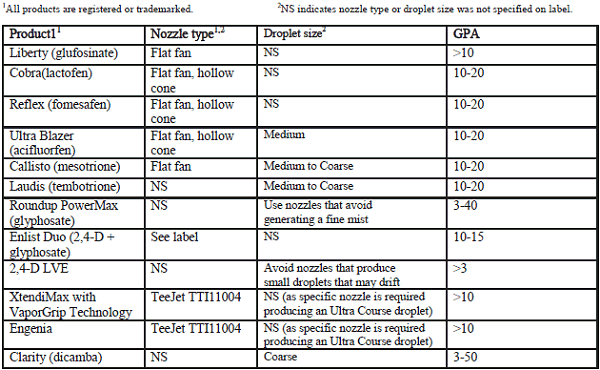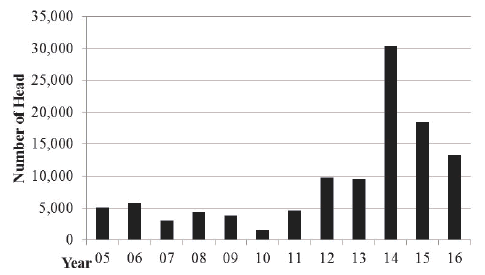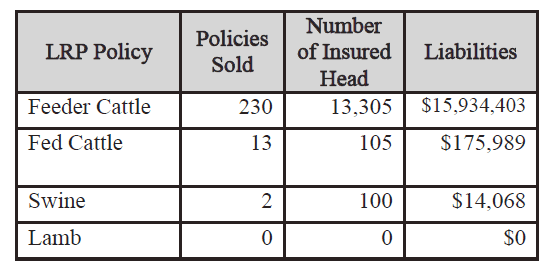

To send a message to an author, click on the author's name at the end of the article.
This Month in Ag Connection | Ag Connection - Other Issues Online
There has been a lot of buzz surrounding dicamba tolerant soybeans for a while, but not until recently had any dicamba formulations been approved for use in dicamba resistant beans. Two new dicamba formulations, XtendiMax with VaporGrip from Monsanto and Engenia from BASF, have been approved by the EPA, and a number of states, for use in Roundup Ready 2 Xtend soybeans. Both of these formulations have significantly lower volatilization potential than older formulations of dicamba products and can be applied as both pre and post applications. With the influx of herbicide resistant weeds, many producers may be interested in implementing this new technology on their operations; however, there are a few things producers should be aware of before utilizing the newer dicamba formulations.
The new dicamba technology may be a useful tool in targeting weeds with herbicide resistance, but is not going to be a silver bullet for weed control. Current weed control programs have come a long way; however, producers cannot afford to repeat past mistakes made with glyphosate tolerant crops. It is imperative farmers continue to use a diverse herbicide program with multiple effective modes of action. With waterhemp being a driver weed, a program with pre-emergent residual herbicides, overlapping residuals and timely post applications will continue to be integral for effective weed control. Herbicide resistant weeds will increase if producers rely only on postemergence applications.
It is important to note XtendiMax and Engenia are much less volatile than older products. The use of dicamba herbicides not specifically labeled for Xtend crops is illegal and may result in substantial fines and/or civil litigation. There are additional low volatile dicamba products awaiting EPA approval. While the newer dicamba formulations are less volatile, there is still a significant potential for physical drift and off-site damage to sensitive non-target plants. The EPA granted registration of XtendiMax and Engenia for use in Xtend crops with two-year supplemental labels, because of the potential of off-target damage and illegal use of older dicamba formulations. Registration extension is possible, but will largely depend on producers using the technology in a responsible manner.
Current labels are fairly restrictive and specifically describe proper use and stewardship of these products, in an effort to reduce off-target damage and other negative impacts. The labels clearly state avoiding spray drift at the application site is the responsibility of the applicator, and instructs the applicator to survey the site for neighboring non-target susceptible crops. Ammonium containing additives, such as ammonium sulfate (AMS), cannot be used because they increase the volatility of the product. Currently, no tank mix products are approved and only the Turbo TeeJet TTI11004 nozzle can be used with these products; however, labels direct applicators to consult the product website, which will list other tank mix products and nozzles if/when they become approved in the future. Ground speed applications should not exceed 15 mph and boom height must be less than 24 inches above target pest or crop canopy. Applications should not be made when there is temperature inversion. Temperature inversions occur when wind speed is less than 3 mph, dew or fog is present and there is little to no cloud cover. Make applications when wind speeds are between 3 and 15 mph, but not when wind speeds are greater than 10 mph in the direction of a sensitive area. The products should not be applied when the wind is blowing toward adjacent commercially grown dicamba sensitive crops. To protect sensitive areas, maintain a downwind buffer of 110 or 220 ft (depending on the application rate) between the last treated row and the closest downwind edge.
The recommendations mentioned above are only a few highlights from the label; subsequently, the supplemental label for these products should be fully read before an application is considered. Understanding all the application guidelines and restrictions of these products may be a challenge, but there are some resources available. A checklist of the "do's and don'ts" is available from the Illinois Fertilizer and Chemical Association and can be found at http://bulletin.ipm.illinois.edu/?p=3802
Product information will be updated on the following two websites: www.engeniatankmix.com and www.xtendimaxapplicationrequirements.com. Information should be checked no more than seven days prior to application.
The Xtend technology is not a silver bullet, but it is a great tool to help manage tough weeds. Strictly adhering to the label and using good common sense is pivotal in preventing off-target damage and keeping this new technology available for years to come.
For more information contact your local University of Missouri Extension agronomy specialist.
Source: Wyatt Miller, Agronomy Specialist
This Month in Ag Connection | Ag Connection - Other Issues Online
In recent years, there have been many advances in nozzle design. The primary improvement has been development of nozzles which minimize the formation of driftable droplets (< 200 micron), while still producing a droplet spectrum that provides the level of coverage required for consistent, postemergence weed control.
The primary factor determining the appropriate spray nozzle is the product being used. Most herbicide labels specify either the nozzle type or droplet size classification (i.e. fine, medium, coarse, extra coarse, or ultra course) that should be used (Table 1). Unfortunately, there is not a uniform system of providing this information on labels.
Table 1. Label recommendations for nozzle type, droplet size, and carrier volume (GPA).

A standardized system of classifying droplet size has been adopted. This information is provided by nozzle manufacturers. Droplet size classification is determined not only by the nozzle type, but also by nozzle size and operating pressure. For example, an XR TeeJet® 11004 operated at 40 PSI is given a rating of medium, whereas, at 50 PSI it is given a rating of fine. When choosing nozzles, be sure to consider the full range of pressures they will be operating under when using rate controllers, which adjust operating pressure based on sprayer speed.
With the introduction of 2,4-D and dicamba resistant crops, specific herbicides (Enlist Duo®, XtendiMax™ with VaporGrip™ Technology and Engenia™) have made selecting nozzles based on droplet size even more important. The Enlist Duo® label lists specific combinations of nozzles and PSI ranges that may be used with this product. This is a new method of regulating the risk of drift associated with herbicide applications adopted by Environmental Protection Agency. Only nozzles that have been evaluated for the range of droplet sizes produced when applying Enlist Duo® can be recommended on the label. The supplemental labels for XtendiMax™ with VaporGrip™ Technology and Engenia™ specify only one nozzle to be used which is the TeeJet® TTI11004.
Spray volume also affects herbicide efficacy. Postemergence applications are often made when weeds are 'shielded' from direct contact with the spray by the crop canopy. Spray volume can have a greater impact on the ability to achieve good coverage of targets within a canopy than the nozzle type. Most herbicide labels recommend increasing spray volume when making applications to large weeds or in situations with dense canopies.
As herbicide programs are adjusted to account for herbicide resistance, the need to alter application methods is often overlooked. Sprayers must be properly equipped and calibrated in order to optimize herbicide performance and minimize the potential for off-target movement.
Article adapted from: Iowa State University Integrated Crop Management news article, http://crops.extension.iastate.edu/cropnews/2016/02/selecting-nozzles-postemergence-herbicides.
The use of trade names in this article is for clarity by the reader. Due to the large number of generic prod-ucts on the market, the author was not able to include all products.
Inclusion of a trade name does not imply endorsement of that particular brand of herbicide and exclusion does not imply non-approval.
Source: Kent Shannon, Natural Resource Engineer
This Month in Ag Connection | Ag Connection - Other Issues Online
Livestock Risk Protection (LRP) insurance provides protection against price declines. It allows producers to put a floor price under the expected sale price of animals, similar to a put option (the right to sell an underlying futures contract at a certain price).
The cost usually ranges from 1-5 percent of the value of the animal. The premium must be paid at the time the policy is purchased.
Policies are subsidized by the federal government at 13 percent, which is much lower than the typical 50% crop insurance subsidy.
To obtain this insurance, producers should find a reputable and experienced agent. A one-time application which establishes producer eligibility is required.
Next, the producer will purchase a Specific Coverage Endorsement (SCE), which includes making the following decisions:
The number of livestock covered in a policy can range from 1 to 1,000 per contract or up to 2,000 in one year (July1 - June 30). A policy can cover sheep, swine or cattle, with cattle being referenced in this article. The types of cattle are split into steers, heifers, dairy, and Brahman. Cattle are insured by weight and classification - Feeder Cattle (under 600#) and Fed Cattle (600-900#).
Coverage level ranges from 70 - 100 percent, but not all coverage levels are available on any given day. As would be expected, when the percentage goes up, so does the cost.
Endorsement length is the time from which the policy is purchased until the expected sale date of the insured animals. This period for feeder cattle can be 13, 17, 21, 26, 30, 34, 39, 43, 47 or 52 weeks. Match the weeks closest to when the cattle will be ready for market. Do not sell any earlier than 30 days before the specified time.
This insurance and the volatility of livestock markets are widespread topics of interest for agriculture and merit watching as the next farm bill approaches.
Thank you to Ryan Milhollin, Economist with University of Missouri Agriculture and Applied Research, for developing the following table and graph, and gathering data from USDA Risk Management Agency website.
Figure 1. LRP Feeder Cattle - Number of Head Insured, Missouri
Source: USDA - Risk Management Agency

Figure 2 - Missouri LRP Usage in 2016
Source: USDA - Risk Management Agency (as of Jan 19, 2017)

Source: Darla Campbell, Ag Business Specialist
Publishing Information
Ag Connection is published monthly for Northeast and Central areas of Missouri producers and is supported by the University of Missouri Extension, the Missouri Agricultural Experiment Station, and the MU College of Agriculture, Food and Natural Resources. Managing Editor: Mary Sobba.